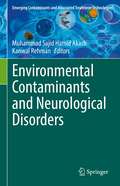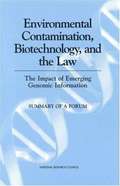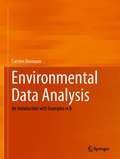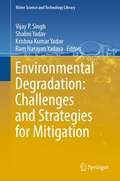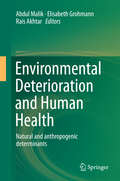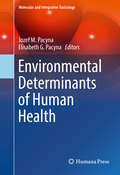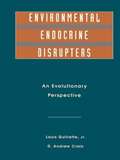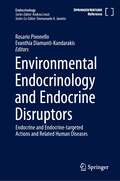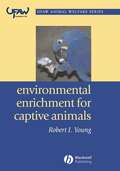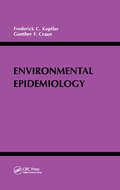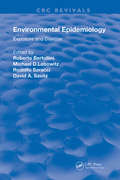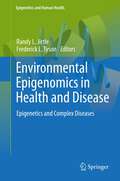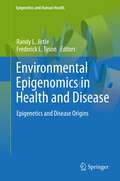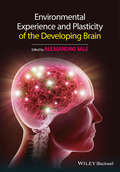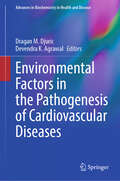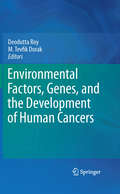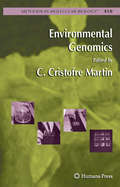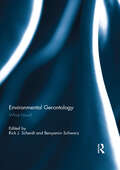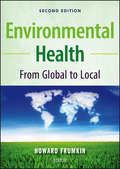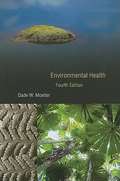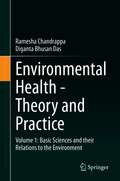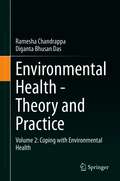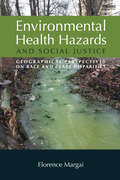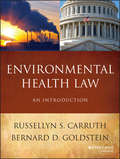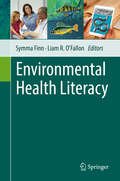- Table View
- List View
Environmental Contaminants and Neurological Disorders (Emerging Contaminants and Associated Treatment Technologies)
by Muhammad Sajid Hamid Akash Kanwal RehmanThis volume discusses how environmental pollutants are involved in the pathogenesis of neurological disorders, and covers specific mechanisms and risk factors, as well as the necessary strategies to reduce the adverse impacts of environmental pollutants on the human nervous system. With a collection of contributions from experts in environmental pollution, neurology and pharmaceutical chemistry, the book provides both an introduction to the pathogenesis of neurodegeneration, including the types and different classes of neurological disorders, and studies demonstrating the clear link between environmental contaminants (e.g. pesticides, smoking, mycotoxins, persistent organic pollutants (POP's), polychlorinated biphenyls, phthalates, nanomaterials) and the development of neurological disorders in vulnerable populations. The book fills in a gap in research on the topic by also covering state-of-the-art treatment strategies and mitigation measures for each type of pollutant. The book will be of interest to environmental scientists, pharmacologists, toxicologists, biochemists, biotechnologists, and food and drug regulatory organizations.
Environmental Contamination, Biotechnology, and the Law: The Impact of Emerging Genomic Information
by Robert PoolA report on Environmental Contamination, Biotechnology, and the Law
Environmental Data Analysis: An Introduction with Examples in R
by Carsten DormannEnvironmental Data Analysis is an introductory statistics textbook for environmental science. It covers descriptive, inferential and predictive statistics, centred on the Generalized Linear Model. The key idea behind this book is to approach statistical analyses from the perspective of maximum likelihood, essentially treating most analyses as (multiple) regression problems. The reader will be introduced to statistical distributions early on, and will learn to deploy models suitable for the data at hand, which in environmental science are often not normally distributed. To make the initially steep learning curve more manageable, each statistical chapter is followed by a walk-through in a corresponding R-based how-to chapter, which reviews the theory and applies it to environmental data. In this way, a coherent and expandable foundation in parametric statistics is laid, which can be expanded in advanced courses.The content has been “field-tested” in several years of courses on statistics for Environmental Science, Geography and Forestry taught at the University of Freiburg.
Environmental Degradation: Challenges and Strategies for Mitigation (Water Science and Technology Library #104)
by Vijay P. Singh Shalini Yadav Ram Narayan Yadava Krishna Kumar YadavThis book discusses problems, challenges, and mitigation strategies in the wake of environmental degradation. It suggests proactive solutions to problems of environmental degradation for strategic planning as well as their effective delivery, and problems arising due to growth in population, industry, and land use change. The uniqueness of the book is its broader spectrum of coverage with related interconnections and interdependence of various aspects. Presenting a wide spectrum of viewpoints and approaches, the book covers topics, such as deforestation impacts (land use and land cover, soil erosion); impacts on climate change and human health; treatment of industrial, municipal, biological waste disposal and their impacts on soil, water, and air; recovery/remediation processes and technologies; impacts of pesticides and chemical fertilizers on soil degradation and groundwater; socio-economic environmental sustainability; and socio-economic health impacts. Particular focus is placed on strategic planning and methodological handling of environmental degradation and remediation through various processes and treatment technologies. This book will be useful to researchers, professionals, policy makers, and environmental engineers.
Environmental Deterioration and Human Health
by Elisabeth Grohmann Abdul Malik Rais AkhtarThis book discusses the natural and anthropogenic determinants of the environment and their impact on human health. It throws light on the perspectives of climate change with case studies from Australia, India, Italy, and Latin America. Themes covered are ecology of antibiotic resistant microorganisms, pesticide and heavy metal (arsenic) problems in natural environment; molecular advances in understanding of microbial interactions; ecological studies of human/animal health and diseases; food security, technological developments and more. The various chapters incorporate both theoretical and applied aspects and may serve as baseline information for future research through which significant development is possible.
Environmental Determinants of Human Health
by Jozef M. Pacyna Elisabeth G. PacynaPolluted air and contaminated food and water are major causes of human health deterioration, but public health policy has long struggled to effectively address these concerns. This timely book--written for a wide audience of policy makers, researchers, and general readers--synthesizes what we already know about environmental hazards, identifies the gaps in our knowledge, and provides a roadmap for reducing human exposure to environmental pollution. With contributions from leading experts, Environmental Determinants of Human Health examines numerous pollutants, both inorganic and organic, in the context of their human health impacts. Individual chapters explore exposure pathways, macroeconomic impacts of human health deterioration, technological and non-technological methods for reducing exposures, monetary and non-monetary benefits from exposure reduction, and risk communication and awareness, including citizen participation approaches. This volume is a crucial text for policy makers requiring scientific justification for the development of new environmental regulations, scientists researching public health and environmental contamination, and members of the public interested in human health issues.
Environmental Endocrine Disruptors: An Evolutionary Perspective
by Jr. Louis J. Guillette D. Andrew CrainAddresses many aspects of endocrine disruption by environmental encountered toxic substances. Initial chapters provide essential background information whilst later chapters address specific aspects of endocrine disrupting contaminants (EDC)
Environmental Endocrinology and Endocrine Disruptors: Endocrine and Endocrine-targeted Actions and Related Human Diseases (Endocrinology)
by Evanthia Diamanti-Kandarakis Rosario PivonelloThis book describes how exposure to various classes of endocrine disruptors, as well as other environmental chemicals targeting the endocrine system by alternative non-endocrine mechanisms, impact on endocrinological and endocrinological-related diseases. It includes comprehensive reviews of all aspects of environmental endocrinology, ranging from sources and patterns of exposure and identification of endocrine targets to direct endocrine disruptive mechanisms and indirect actions on the endocrine system, the latter including endocrine cell-directed cytotoxicity, oxidative damage, and genetic and epigenetic aberrations resulting in endocrine damage. It also examines the causal pathways and offers an extensive overview of downstream endocrinological and endocrinological-related disorders. In addition, several chapters focus on transgenerational actions, which are a topic of particular interest. Lastly, evidence from preclinical and clinical studies provides the basis for an in-depth, critical discussion of each topic. The book is part of the SpringerReference program, which provides access to ‘living editions’ that are constantly updated using a dynamic peer-review publishing process.
Environmental Enrichment for Captive Animals (UFAW Animal Welfare #1)
by Robert J. YoungEnvironmental enrichment is a simple and effective means of improving animal welfare in any species – companion, farm, laboratory and zoo. For many years, it has been a popular area of research, and has attracted the attention and concerns of animal keepers and carers, animal industry professionals, academics, students and pet owners all over the world. This book is the first to integrate scientific knowledge and principles to show how environmental enrichment can be used on different types of animal. Filling a major gap, it considers the history of animal keeping, legal issues and ethics, right through to a detailed exploration of whether environmental enrichment actually works, the methods involved, and how to design and manage programmes. The first book in a major new animal welfare series Draws together a large amount of research on different animals Provides detailed examples and case studies An invaluable reference tool for all those who work with or study animals in captivity This book is part of the UFAW/Wiley-Blackwell Animal Welfare Book Series. This major series of books produced in collaboration between UFAW (The Universities Federation for Animal Welfare), and Wiley-Blackwell provides an authoritative source of information on worldwide developments, current thinking and best practice in the field of animal welfare science and technology. For details of all of the titles in the series see www.wiley.com/go/ufaw.
Environmental Epidemiology
by Frederick C. KopflerThis informative book is valuable to a broad spectrum of individuals active in the environmental and health sciences, including chemists, epidemiologists, and mathematics modelers, as well as those involved with measurement and effects of numerous kinds of drinking water contamination and both indoor and ambient air pollution. Environmental researchers involved with human exposure to toxic substances, regulators and administrators will also find this work of value.
Environmental Epidemiology: Exposure and Disease (Routledge Revivals)
by M. P. H. Fccp Roberto Bertollini Michael D. Lebowitz Face Rodolfo Saracci David A. SavitzPublished in 1996: Environmental Epidemiology: Exposure and Disease is a unique resource identifying priorities for public health research in selected areas of environmental epidemiology. Drawn from the proceedings of an international workshop on this topic, the book is a compilation of the specialized knowledge and opinions of environmental epidemiology experts. Organized by the Rome division of the World Health Organization (WHO) European Centre for Environment and Health, the goal of the 1993 workshop, Setting Priorities in Environmental Epidemiology, was to establish a consensus among the experts in the selected areas. The chapters in Environmental Epidemiology: Exposure and Disease cover environmental epidemiology from three different viewpoints: environmental exposures, major disease groups related to the environment, and epidemiological methodology. The environmental exposure categories examined for prioritizing are air contaminants, water contaminants, and ionizing and non-ionizing radiation exposure from human-caused disasters. .
Environmental Epigenomics in Health and Disease: Epigenetics and Complex Diseases
by Randy L. Jirtle Frederick L. TysonThere are now compelling human epidemiological and animal experimental data that indicate the risk of developing adult-onset complex diseases and neurological disorders are influenced by persistent epigenetic adaptations in response to prenatal and early postnatal exposures to environmental factors. Epigenetics refers to heritable changes in gene function that occur without a change in the sequence of the DNA. The main components of the epigenetic code are DNA methylation, histone modifications, and non-coding RNAs. The epigenetic programs are established as stem cell differentiate during embryogenesis, and they are normally faithfully reproduced during mitosis. Moreover, they can also be maintained during meiosis, resulting in epigenetic transgenerational disease inheritance, and also potentially introducing phenotypic variation that is selected for in the evolution of new species. The objective of this two volume book is to provide evidence that environmental exposures during early development can alter the risk of developing medical conditions, such as asthma, autism, cancer, cardiovascular disease, diabetes, obesity, and schizophrenia later in life by modifying the epigenome. Consequently, epigenetic research promises to markedly improve our ability to diagnosis, prevent, and treat the pathological conditions of humans; however, it also introduces unique legal and ethical issues. This volume highlights the correlation between environmental factors and complex diseases, such as autism, addiction, neurological diseases, diabetes, obesity and cancer. It concludes with a chapter on legal and ethical implications of epigenetics.
Environmental Epigenomics in Health and Disease: Epigenetics and Disease Origins
by Frederick L. Tyson Randy L JirtleThere are now compelling human epidemiological and animal experimental data that indicate the risk of developing adult-onset complex diseases and neurological disorders are influenced by persistent epigenetic adaptations in response to prenatal and early postnatal exposures to environmental factors. Epigenetics refers to heritable changes in gene function that occur without a change in the sequence of the DNA. The main components of the epigenetic code are DNA methylation, histone modifications, and non-coding RNAs. The epigenetic programs are established as stem cell differentiate during embryogenesis, and they are normally faithfully reproduced during mitosis. Moreover, they can also be maintained during meiosis, resulting in epigenetic transgenerational disease inheritance, and also potentially introducing phenotypic variation that is selected for in the evolution of new species. The objective of this book is to provide evidence that environmental exposures during early development can alter the risk of developing medical conditions, such as asthma, autism, cancer, cardiovascular disease, diabetes, obesity, and schizophrenia later in life by modifying the epigenome.
Environmental Experience and Plasticity of the Developing Brain
by Alessandro SaleEnvironmental Experience and Plasticity of the Developing Brain goes beyond the genetic basis of neurodevelopment. Chapters illuminate the external factors that can dramatically impact the brain early in life and, consequently, the eventual accomplishment of developmental milestones and the construction of adult behavior and personality. Authored and edited by leaders in this rapidly growing field, Environmental Experience and Plasticity of the Developing Brain not only surveys preexisting literature on the effects of environment versus genetics, but also discusses more recent studies on the impacts of neurodevelopment in terms of maternal stimulation, environmental enrichment and sensory deprivation. The book also includes key examples of environmental impacts on preexisting genetic syndromes leading to developmental disabilities. Focus is also given to the consequences of early adverse experience in primates, as well as neurobiological and behavioral consequences in institutionalized human children and the reversibility of such consequences. Environmental Experience and Plasticity of the Developing Brain encompasses a broad area of research in the field of developmental neurobiology and offers a unique combination of different examples of environmental factors affecting brain development and behavior.
Environmental Factors in the Pathogenesis of Cardiovascular Diseases (Advances in Biochemistry in Health and Disease #30)
by Devendra K. Agrawal Dragan M. DjuricEnvironmental conditions and processes are one of the major pillars on which the human well-being rests. It is the core responsibility of the society to preserve and enhance better conditions for the human well-being. Indeed, there are several evolving unmet needs in public health. Emerging and re-emerging infectious diseases and a surge in the incidence of non-communicable diseases, including cardiovascular diseases (CAD), chronic respiratory diseases, and metabolic diseases have been impediments to sustainable well-being. Many factors are critical in the global surge in the rate and incidence of cardiovascular diseases. These include the shift from acute to chronic conditions, the shift from single risk factor vs. multiple influences, aging population, global health disparities, exposure to lower harmful influences over a longer period, etc. However, the epigenetic factors due to unhealthy environment play a most significant role in the underlying pathogenesis of cardiovascular diseases. Unfortunately, this has been ignored for a long time and realized lately to expand and disseminate knowledge to general population, expand research activities to investigate the cellular and molecular mechanisms, and develop better preventive and treatment strategies. The most significant environmental impoverishment in the pathogenesis of cardiovascular diseases include different genetical, chemical, physical, and biological influences, but not limited to, socio-economic status and lack of nutrients, nutritional aspects including habits, diets and additives, inhaled and ingested pollutants, exhaust gas and gasoline products, tobacco smoke, water pollution, alcohol consumption, soil and mineral pollution, solvents, pesticides, microplastics, non-critical usage of drugs, climate change, extreme atmospheric conditions, extremes in noise and temperature, electromagnetic influences, microwaves and radiation, outdoor light pollution, mental stressors, lack of or over exercise, microbiota and microbiological agents like SARS CoV-2 virus, etc.
Environmental Factors, Genes, and the Development of Human Cancers
by Deodutta Roy M. Tevfik DorakCancer is a complex disease. Only 5-10% of human cancers are hereditary in nature. Many of us think of environmental agents when we think of carcinogens. The environment includes all that surrounds us, and environmental influences include not only chemical, physical and biological toxicants, but also diet and lifestyle. In this broadest sense, the environment contributes substantially in the development of human cancer. This book will describe how environment contributes to malignant transformation leading to profound changes in the genetic and signaling networks that control the functioning of the cell. It will critically discuss the understanding of the effects of environment on the development, progression and metastasis of cancer with current knowledge of the signaling networks that support functioning of transformed human cells. Genes and environmental factors that influence the origins of cancer are not necessarily the same as those that contribute to its progression and metastasis. Susceptibility gene variants for each specific cancer are being identified with emerging evidence of gene-environment interaction. Gene-environment interactions will be discussed through each specific cancer-based approach to address the question of how genetic variations can influence susceptibility to the individual type of cancer. It will also highlight and summarize epigenetic changes that increase the risk for susceptibility to a particular type of cancer, particularly in the presence of specific environmental factors. Thus, this book will contain chapters from the world's experts focused on the current evidences that support the role of environment in the cancer etiology and in the growth of malignant lesions, and discuss who may be susceptible to environmental influences.
Environmental Genomics
by C. Cristofre MartinHere is a manual for an environmental scientist who wishes to embrace genomics to answer environmental questions. The volume covers: gene expression profiling, whole genome and chromosome mutation detection, and methods to assay genome diversity and polymorphisms within a particular environment. This book provides a systematic framework for determining environmental impact and ensuring human health and the sustainability of natural populations.
Environmental Gerontology: What Now?
by Benyamin Schwarz Rick J. ScheidtEnvironmental gerontology – the research on aging and environment – evolved during the late 1960s, when the domain became a relevant topic due to societal concerns with the problems of housing for elderly people. The field proliferated during the 1970s and 1980s, and remains viable and active today on an international scale. However, in recent times, the viability of the field and its future has been brought into question. In this volume, international experts across diverse areas reflect on the current progress of their respective disciplines, illustrating research-grounded benefits emerging from their work, and suggesting new agenda that can guide progress in the future. The contributors address a wide range of issues, including: evaluation of existing paradigms and new theories that might advance both research and training; issues and applications in methods, measures, and empirically-generated research agenda; innovative approaches to environmental transformations in home, community, and long-term care settings; and understudied populations and issues in environmental gerontology. This book was originally published as a special issue of the Journal of Housing for the Elderly.
Environmental Health
by Mph Howard FrumkinThe second edition of Environmental Health: From Global to Local, a comprehensive introductory text, offers an overview of the methodology and paradigms of this burgeoning field, ranging from ecology to epidemiology, from toxicology to environmental psychology, and from genetics to ethics. Expert contributors discuss the major issues in contemporary environmental health: air, water, food safety, occupational health, radiation, chemical and physical hazards, vector control, and injuries. Also emphasizing a wide variety of issues of global interest, the thoroughly revised second edition contains updated information on such timely topics as toxicology, exposure assessment, climate change, population pressure, developing nations and urbanization, energy production, building and community design, solid and hazardous waste, and disaster preparedness. In addition, each chapter of Environmental Health includes learning objectives, key points, and discussion questions. Praise for the first edition of Environmental Health"A classic textbook for the dynamic, evolving field of environmental health, thoughtful, well written, well balanced and referenced. An excellent overview of a multifaceted approach to environmental health."- AOEC Newsletter (Association of Occupational and Environmental Clinics)"With its many examples, clear explanations, and emphasis on big picture themes and relevance, it is an astonishingly interesting read."-Global Public Health "The book's chapters contain highly pertinent insights and information on environmental issues that go beyond the usual boundaries of classic environmental health."-Environmental Health Perspectives Winner, AAP Award for Excellence in Professional and Scholarly Publishing
Environmental Health (Fourth Edition)
by Dade W. MoellerBased on the recommendations of advisory bodies and federal agency regulations, as well as a thorough review of the scientific literature, Moeller's Fourth Edition is the only fully current text in this burgeoning field. It features new tables and figures, and revisions of those retained from previous editions. Environmental Health is also enriched with the knowledge and insights of professionals who are deeply involved in "real world" aspects of each subject covered. In eighteen chapters, students receive a complete but manageable introduction to the complex nature of the environment, how humans interact with it, and the mutual impact between people and the environments where they work or live. This new edition emphasizes the challenges students will face in the field: the local and global implications of environmental health initiatives, their short- and long-range effects, their importance to both developing and developed nations, and the roles individuals can play in helping to resolve these problems. Whether discussing toxicology, injury prevention, risk assessment, and ionizing and non-ionizing radiation, or more traditional subjects like the management and control of air, water, and food, Dade Moeller emphasizes the need for a systems approach to analyzing new projects prior to their construction and operation. Environmental Health is indispensable reading for practitioners, students, and anyone considering a career in public health.
Environmental Health - Theory and Practice: Volume 1: Basic Sciences and their Relations to the Environment
by Ramesha Chandrappa Diganta Bhusan DasThis two-volume work discusses environmental health, the branch of public health concerned with all aspects of the natural and built environment affecting human health, and addresses key issues at the global and local scales. The work offers an overview of the methodologies and paradigms that define this burgeoning field, ranging from ecology to epidemiology, and from pollution to environmental psychology, and addresses a wide variety of global concerns including air quality, water and sanitation, food security, chemical/physical hazards, occupational health, disease control, and injuries. The authors intend to provide up-to-date information for environmental health professionals, and to provide a reference for students and consultants working at the interface between health and environmental sectors. Volume 1 focuses on discussing the fundamentals of physical, chemical, and biological sciences in an environmental health context, and introduces the key concepts that bridge environmental health and medical sciences to accurately inform both environmental and medical professionals. The book addresses different specializations in medical science that account for environmental health issues, and aims to reduce the knowledge gap among professionals on public health topics such as pollution impacts, occupational hazards, radiation exposure, natural disasters, and climate change.
Environmental Health - Theory and Practice: Volume 2: Coping with Environmental Health
by Ramesha Chandrappa Diganta Bhusan DasThis two-volume work discusses environmental health, the branch of public health concerned with all aspects of the natural and built environment affecting human health, and addresses key issues at the global and local scales. The work offers an overview of the methodologies and paradigms that define this burgeoning field, ranging from ecology to epidemiology, and from pollution to environmental psychology, and addresses a wide variety of global concerns including air quality, water and sanitation, food security, chemical/physical hazards, occupational health, disease control, and injuries. The authors intend to provide up-to-date information for environmental health professionals, and to provide a reference for students and consultants working at the interface between health and environmental sectors. Volume 2 covers the technological, legislative, and logistical solutions for coping with environmental health issues. The principles of environmental legislation are explained in national and international contexts, and assessments are mapped out to craft informed governance plans for health and environmental management. Mitigation measures are introduced to control wastewater and solid waste management and air and noise pollution, and adaptation strategies for emergency preparedness and disaster recovery are discussed.
Environmental Health Hazards and Social Justice: Geographical Perspectives on Race and Class Disparities
by Florence MargaiThis book provides geographic perspectives and approaches for use in assessing the distribution of environmental health hazards and disease outcomes among disadvantaged population groups. Estimates suggest that about 40 per cent of the global burden of disease is attributable to exposures to biological and chemical pathogens in the physical environment. And with today's rapid rate of globalization, and these hazardous health effects are likely to increase, with low income and underrepresented communities facing even greater risks. In many places around the world, marginalized communities unwillingly serve as hosts of noxious facilities such as chemical industrial plants, extractive facilities (oil and mining) and other destructive land use activities. Others are being used as illegal dumping grounds for hazardous materials and electronic wastes resulting in air, soil and groundwater contamination. The book informs readers about the geography and emergent health risks that accompany the location of these hazards, with emphasis on vulnerable population groups. The approach is applications-oriented, illustrating the use of health data and geographic approaches to uncover the root causes, contextual factors and processes that produce contaminated environments. Case studies are drawn from the author's research in the United States and Africa, along with a literature review of related studies completed in Europe, Asia and South America. This comparative approach allows readers to better understand the manifestation of environmental hazards and inequities at different spatial scales with localized disparities evident in both developed and developing countries.
Environmental Health Law
by Russellyn S. Carruth Bernard D. GoldsteinThis important resource offers a comprehensive overview of the major U. S. environmental laws and approaches, strategies, standards, and enforcement techniques by which American law protects our environment and our health. Written for the non-lawyer, the book puts the spotlight on general concepts that go a long way to demystify the American legal system (what law consists of, who makes it, how it is made, and how it is enforced). The authors also introduce the major environmental laws and evaluate issues, controversies and developments in environmental policy.
Environmental Health Literacy
by Symma Finn Liam R. O'FallonThis book explores various and distinct aspects of environmental health literacy (EHL) from the perspective of investigators working in this emerging field and their community partners in research. Chapters aim to distinguish EHL from health literacy and environmental health education in order to classify it as a unique field with its own purposes and outcomes. Contributions in this book represent the key aspects of communication, dissemination and implementation, and social scientific research related to environmental health sciences and the range of expertise and interest in EHL. Readers will learn about the conceptual framework and underlying philosophical tenets of EHL, and its relation to health literacy and communications research. Special attention is given to topics like dissemination and implementation of culturally relevant environmental risk messaging, and promotion of EHL through visual technologies. Authoritative entries by experts also focus on important approaches to advancing EHL through community-engaged research and by engaging teachers and students at an early age through developing innovative STEM curriculum. The significance of theater is highlighted by describing the use of an interactive theater experience as an approach that enables community residents to express themselves in non-verbal ways.
